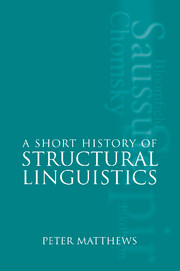4 - Diachrony
Published online by Cambridge University Press: 03 December 2009
Summary
From the 1940s onwards structural linguists were increasingly distinct from linguists in general. Structuralist schools were not established equally in all countries: scarcely at all, for example, in Italy or in Germany. But in the United States especially to be ‘a linguist’ was increasingly to be a structuralist. Above all, it was to be a ‘descriptive’ linguist. The term ‘descriptive’ has many resonances, and can easily be misunderstood. But for Americans its sense was like that of Saussure's ‘synchronic’. In a leading introduction to linguistics, ‘descriptive or synchronic linguistics’ was the study of ‘how a language works at a given time, regardless of its past history or future destiny’ (Hockett, 1958: 303). It deals with ‘the design of the language of some community at a given time’ (321).
But Saussurean linguistics also had a ‘diachronic’ or historical branch. How was that affected?
When the Cours appeared this branch was dominant. Saussure himself had been young in Leipzig in the 1870s, when the so-called ‘Junggrammatiker’ or ‘neogrammarians’ formulated basic principles of change in language. It was through their work above all that, we are told, ‘linguistics in the true sense’ (‘la linguistique proprement dite’) had been born (Saussure, 1972 [1916]: 18f.). It is not surprising therefore that the chapters of the Cours devoted to its diachronic side (Part 3, 193ff.) say so little that was new. Of the structuralists who followed, Bloomfield had been trained in the tradition of the neogrammarians, and his masterly account of language change, which forms most of the latter half of Language, was based firmly on their principles.
- Type
- Chapter
- Information
- A Short History of Structural Linguistics , pp. 52 - 73Publisher: Cambridge University PressPrint publication year: 2001



